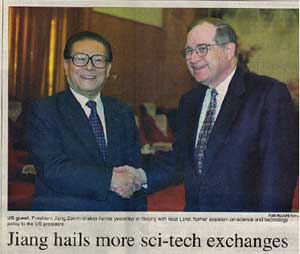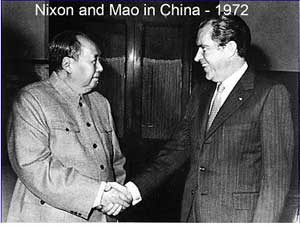Science Diplomacy
Session Y5 at the April meeting
Chaired and reported by Harvey Newman
"Science Diplomacy" presented perspectives on this important issue in its various forms, from encouraging technological progress and economic development in the third world, to promoting equality and peace on a foundation of open international scientific collaboration, to the relationship to political policy. The distinguished speakers included: APS President and Caltech Professor Emeritus Barry Barish, Neal Lane, a Senior Fellow in Science and Technology Policy at the Baker Institute and a former NSF Director as well as the former Science Advisor during the Clinton Administration, and Norman Neureiter who is the Director of the AAAS Center for Science, Technology and Security Policy and was the Science Advisor to the Secretary of State during the Bush administration.
Speaking on "Science Diplomacy in Large International Collaborations", Barish spoke of the emergence of such collaborations in several fields of physics as the result of the imperative to combine resources, skills and ideas in a shrinking world empowered by communications and collaborative technologies, and the implications for U.S. science policy. The importance of pursuing each project varies from national priorities (ITER) to strategic priorities in the South Pole laboratory to transformational science and frontier research in ALMA, AUGER, LHC, AMS, ILC, SKA and many others. The tangible side benefits of such large scale projects are many, from the World Wide Web to accelerator development driving materials science as well as medical and industrial applications, and the development of large state-of-the-art facilities "advances technological technology applications for society, often in unpredictable ways."
After commenting on the varied forms of partnership in the projects mentioned, Barish returned to his central themes: "Developing and supporting such large facilities must be an important part of U.S. Science Policy, in order to keep U.S. science at the forefront", and "the U.S. must be part of the most important science to be most competitive and to have the biggest impact on society." He used the progress of the ILC Global Design Effort as a success example, while highlighting the key role of governments in establishing global projects that can move forward to successful completion over a period of one or more decades. He highlighted the challenges of integrating the U.S. system, with its one-year funding cycle and particular ways of governance, project management and accountability with those of other countries and/or international organizations. Looking to the future, if the U.S. aspires to host a major international project to do frontier science, Barish said: "we must solve problems of governance, visas, in-kind contributions, accountability, contingency and [the way we handle] cost overruns" to work effectively with our international partners.
Speaking on "A Scientist’s Approach to Diplomacy – First Listen and Learn", Lane opened by quoting J. Thomas Ratchford (FIP Chair in 1996): "Physics is perhaps the most international of all human endeavors. Physicists naturally think internationally, and their closest research collaborators are as likely to be across the world as across the hall…" This helps explain why scientists, and physicists in particular, have been so effective in facilitating or paving the way for international cooperation, along with the simple fact that many scientists have the ability to listen and learn. Lane spoke of two angles on science diplomacy: Diplomacy for Science which includes "research collaborations, international conferences and shared facilities" and Science for Diplomacy that includes the "use of scientific research to improve relations between nations; help solve world problems; protect the earth's environment and biodiversity, etc." As a former NSF Director, he reflected on NSF's many international activities, noting that NSF funding is largely reserved for international research and education activities in the U.S., or by the U.S. participants in an international collaborative project.

As a former head of the Office of Science and Technology Policy, Lane gave examples of the S&T agreements with many nations regarding exchanges, joint research, and shared facilities, including those with individual nations including Russia, China, India and Japan, as well as international organizations such as OECD, UNESCO and CERN. He also gave compelling examples of his own involvement, as when he discussed nanotechnology with China's President Jiang Zemin in 2001 (captured in the photo from the China Daily, November 27, 2001):
He then highlighted the 2006 U.S. – China S&T Forum where he had spoken of a "time of unprecedented opportunity for cooperative research between the U.S. and China" and "the time is right to launch a new era in U.S. – China cooperation in science and technology"; sentiments that have been strongly echoed recently by the present Science Advisor John Holdren ("U.S. - China science and technology cooperation remains one of the strongest aspects of our bilateral relationship") in response to the 'Wolf clause' inserted into the April 2011 spending bill that seeks to prohibit funding for NASA or OSTP activities that further such cooperation http://news.sciencemag.org/scienceinsider/2011/04/spending-bill-prohibits-us-china.html.
The lessons drawn by Lane, based on his decades as a science policy maker and diplomat are both simple and pro-found. "Science is a unique platform to promote cooperation, understanding and shared values among individuals, communities and nations even in difficult times." This is as evident now as it was during the Cold War, when physicists unrelentingly maintained a bridge of cooperation with Soviet scientists and laboratories, organized many international activities through the APS, and spoke out repeatedly on the need for nuclear arms control and reduction, and the freedom of scientists through such organizations as the Federation of American Scientists and the Union of Concerned Scientists that they formed. Citing the many global challenges ahead, from the energy to climate change to education and the competitiveness of the U.S. workforce, Lane noted that the solutions to these problems require major actions, with direct involvement by scientists on many fronts to bring about:
Major advances in science and technology
A renewed commitment to university research
Substantial growth in international research cooperation, particularly between the U.S. and Asia, and
Involvement of many more scientists with government policy and the general public, a role some of us call the "civic scientist."
Lane concluded by calling on the physics community to get involved, or stay involved with renewed effort: "if we are serious about helping deal with global challenges, we will need global 'civic scientists', whom we might call 'science diplomats'."

Norm Neureiter spoke on "Science Diplomacy in Action", drawing on his own 50+ years of experience in international affairs, science policy and science diplomacy. He reviewed the science policy perspectives and contrasts among the U.S. administrations of Eisenhower, Kennedy, Nixon, Johnson and Carter, illustrating them with many remarkable photographs of moments in history (such as the meetings of Nixon and Khrushchev, Nixon and Brezhnev, Nixon and Mao, Carter and Deng Xiaoping) where he was present.
He then highlighted the role of scientists in arms control through the Pugwash Conferences founded in 1957, that have evolved into an international organization dedicated to nuclear disarmament.
Turning to more recent times, Neureiter recalled his own visits to Iran, Myanmar and Cuba, and his key role in "backdoor diplomacy" that provides a communications channel and a possible road to improved relations through cooperative work among scientists on non-sensitive issues, even with regimes unfriendly to the U.S. government. He showed how Nobel prizewinner John Taylor, highly revered in Iran, was effective in fostering a spirit of cooperation there. Neureiter then told of the remarkable case of a North Korean self-made businessman whom he met, who dedicated his fortune to establishing the Pyongyang University of Science and Technology, which through a twist of fate was instrumental in saving the businessman's life when he was accused of spying, while opening a new channel for cooperation with scientists in the U.S.
Neureiter then turned to a series of lessons learned, and the challenges to be faced. The key lessons are that "science is an area where communication is easier and understanding more likely" that "can open doors to influential people" and "lead to real mutually beneficial cooperation in non-sensitive areas". The challenges are "facing down criticism of helping 'the enemy'", carrying on meaningful follow-on visits; finding good cooperators and funding on the U.S. side; and persevering in spite of shifting political winds. His powerful conclusion on the global imperative of international S&T cooperation, closing the session, is captured here:
(The talks can be seen at http://www.physics.wisc.edu/apsapril2011)

Disclaimer - The articles and opinion pieces found in this issue of the APS Forum on International Physics Newsletter are not peer refereed and represent solely the views of the authors and not necessarily the views of the APS.
